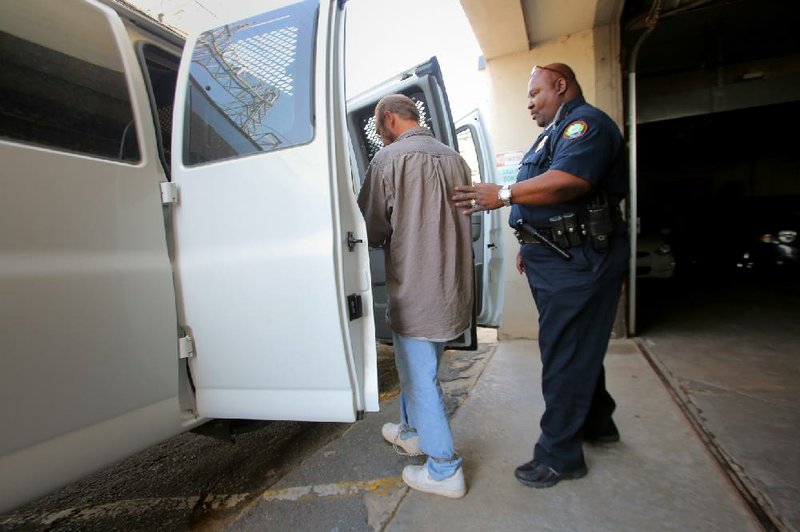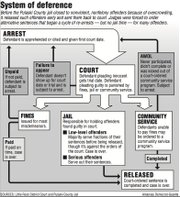During a recent session of Little Rock District Traffic Court in Judge Vic Fleming's courtroom, Anthony Piggee was scheduled to face his 19th charge of driving without a license and his 12th charge of driving without insurance. He had been released from jail with a citation to appear in court. But he didn't show up.
It wasn't the first time Piggee had been released on a citation, and it wasn't the first time he hadn't shown up when his name was called in open court, court records say. Exasperated, Fleming issued another arrest warrant for Piggee and told the crowded courtroom, "The administration of justice is suffering."
Fleming's declaration is an indication of the frustration he and District Criminal Court Judge Alice Lightle say has increased in recent years as they work to punish offenders.
Last month, the overcrowded Pulaski County jail decided to accept only the most serious offenders. It released scores of misdemeanor offenders before those offenders appeared in court, which Lightle lamented amounts to a "catch and release" process. Criminals are caught, appear in court and are ordered to serve jail time, but are released by the jail after serving only fractions of their ordered time. Or, they are arrested and released by the jail with an order to show up for their initial court appearances.
And the available community service programs, which are intended to be alternatives to jail time, have been either mismanaged or run with middling results, leaving judges frustrated over their options for punishing low-level offenders.
"There are people who, according to the law and according to what I perceive to be the community standards, need to be placed in jail just in order to accomplish basic justice," Fleming said. "And when the jail says 'we're closed, we're not going to keep these people,' the next best thing is to send them to the community service program.
"If the community service program sends us a note that says 'put a warrant out because this person failed to show up,' we do that ... and when those people are apprehended, if they are, they're taken to the jail and then released and told to go back to court. And that's the vicious cycle that we're battling right now."
Lightle said the cases handled in district court often don't involve the most serious crimes, but Little Rock faces serious "quality-of-life" issues if multitudes of petty thieves, fraud perpetrators and habitual traffic offenders cannot be held accountable for their actions.
Untrusted alternative
Overcrowding at the jail forces judges to look more at community service programs, but for several years now, judges have seen problems in those programs, as well.
Rather than sentence offenders to jail time, Fleming and Lightle have referred hundreds each year to two community service programs where offenders work off their sentences doing things like picking up trash and mowing lawns on public properties. The two programs are run by Little Rock's Department of Housing and Neighborhood Programs and by the Pulaski County sheriff's office.
But concerns surfaced over record-keeping in Little Rock's program, and they were serious enough for Lightle and Fleming to stop sending offenders there for months at a time, according to more than eight years of records analyzed by the Arkansas Democrat-Gazette.
Fleming stopped using Little Rock's program from about August 2012 to January 2013, said Lisa Tatum, traffic court administrator. Fleming said he didn't trust the information the program was reporting to his court.
"We'd get batches of requests for arrest warrants, often indicating that defendants here and there had not shown up for several months," he said. "We'd go weeks at a time with no reporting from [the program's coordinator] at all. Very frustrating."
Housing and Neighborhood Programs officials were supposed to send the district court monthly reports on the number of traffic offenders who completed community service, received credit for time served in jail or went "AWOL" -- meaning they were kicked out of the program, didn't finish it or never showed up for it.
Gaps in the program's reporting to traffic court began in 2008. That year, the program failed to provide data for the month of June. The next year, there were four months in which no data were reported. In 2010, another four months.
Also in 2010, program officials reported an AWOL rate of 125 percent for traffic offenders, which wildly contrasted with other years. Excluding that year, since 2006 the program has reported an average annual AWOL rate of slightly more than 21 percent.
Neighborhood and Housing Director Andre Bernard said that while it is possible that the reported AWOL rate in 2010 is correct -- some offenders are re-arrested and repeatedly go AWOL -- it was likely inaccurate because of flawed record-keeping.
In 2011, there were nine months in which no data were reported to traffic court. And in 2012, eight months of data weren't provided.
According to records, about 30 traffic offenders were being ordered into the community-service program each month. When Fleming stopped using it, many of those offenders were sent to the county's community-service program, which is conducted at the Pulaski County jail.
Lightle said she also stopped sending offenders to Little Rock's program. She couldn't provide details showing when and for how long, but said it was for "a couple of years."
"Record-keeping over there was a big problem," she said.
Lightle was unsure how many offenders she diverted to the county program during that time.
Program troubles
Lightle and Fleming resumed sending offenders to Little Rock's community service program after its coordinator, Patricia Bass, departed in December 2012.
Bass' nearly seven years as coordinator were marked by poor record-keeping and other problems, according to records. Responsible for processing court documents and requesting arrest warrants for AWOL participants, she was disciplined on multiple occasions for mismanaged records and other matters, records show.
She received a written reprimand in 2008 and was suspended for two days without pay in 2011 for "repeated failure to keep up with required paperwork for community punishment personnel," according to a city-issued disciplinary action form.
Records show that Bass, who was also responsible for transporting program participants to and from work sites, crashed a city vehicle in July 2012 while transporting a participant. She then tested positive for methamphetamines and amphetamines, according to a disciplinary form, and was suspended from work for 30 days and ordered to enroll in a substance-abuse program. She later transferred to the city's maintenance department.
Bass did not respond to phone calls seeking comment.
Lightle said the program appears to be "under better control now." Depending on the number of participants in the program, the criminal court receives reports biweekly or monthly.
Fleming has sent 576 traffic offenders there in the 16 months since Bass left. He had been sending an average of 370 offenders to the program each year, but sent only 85 during the final year that Bass was in charge.
Reports are now sent to his court weekly.
Bernard, who supervised Bass, said more frequent reports are part of "enhanced oversight" by program officials. And increased communication between the program's administrators and staff members has resulted in "fewer complaints" from the courts, he said.
Burden at the jail
On April 29, Pulaski County jail officials closed the lockup to nonviolent, nonfelony offenders after determining that the prisoner population had reached a critical level. Sheriff Doc Holladay said the jail had consistently been holding about 1,300 prisoners. Its capacity is 1,210.
The decision followed an unprecedented 17.7 percent increase in the Arkansas prison population in 2013. On any given day in Pulaski County, 25 percent to 40 percent of jail prisoners are awaiting space to open up for them in state prisons, which are also overcrowded.
That backlog of state prisoners in county jails has forced jail officials to release low-level offenders before their sentences are complete, Holladay said. It has also forced the jail to release low-level offenders who are awaiting court dates.
"We are on the side of the court. We know their frustration," Holladay said. "But we have some of the same frustration because we are not able to accommodate them."
Frustration for the courts and the jail was at its highest when Little Rock's community service program was in such turmoil. Lightle and Fleming diverted numerous offenders from the Little Rock program to the county program, which is run out of the county jail.
Pulaski County jail Chief of Detention Randy Morgan said the increase in participants was not what the overpopulated jail needed.
"I don't have unlimited staff," Morgan said. "But we've never told them they couldn't send [more offenders]. Our [number of program participants] went way up when the Little Rock program went to crap. They all came on over."
Fleming said that on the recommendation of prosecutors, he and "probably every judge in the county" have been giving lighter sentences because of overcrowding at the jail. Increasingly, those lighter sentences have been community service, which Lightle said is "not a particularly desired option."
When she and Fleming diverted offenders to the county program, they were sending the offenders to a program that nearly half didn't finish. Since 2006, 48 percent of 10,945 traffic offenders sent to the program have gone AWOL, according to records.
Arrest warrants were issued for offenders who didn't show up for court-ordered community service. But "word got around" among offenders that because of overcrowding, the jail would not hold them if they were arrested for going AWOL, Morgan said.
"When you lose that certainty of accountability," Holladay said, "you've lost the effectiveness of the alternative program. In other words, if these individuals realize that they're not going to be [jailed] for their failure to comply with the terms of their sentence, then they just choose to ignore the sentence altogether."
Since the jail closed to low-level offenders, some of them have been sent to jails in other counties. But the majority are fingerprinted, entered into a state database, are given citations to appear in court and are released.
For repeat offenders, the process is especially frustrating, Fleming said.
"You send people to a program when your own internal clock says you shouldn't be sending them to that program, they should be going to jail," he said.
"Catch and Release"
Jail officials said they decide how long an offender is locked up based on the severity of the charges. Specifically, offenders have been divided into two categories, "A" and "B."
On the "A" list are 113 felony offenses for which a prisoner will not be released early, whether he's in jail awaiting his first court date or has been sentenced to jail time. Offenses on the "A" list include aggravated assault, arson, murder, residential burglary, kidnapping and rape.
The "B" list consists of 187 lesser offenses -- including driving while intoxicated, computer and credit card fraud, dog-fighting, forgery, theft of property, breaking or entering, and multiple drug possession charges -- for which the jail will release an offender before his court appearance or completion of his sentence.
When an offender awaiting his initial court appearance is released by the jail, he is given a citation to appear in court -- called an appearance agreement -- and he is subject to arrest if he doesn't show up for court.
But failure to appear in court is among the jail's "B" list charges. So if a released offender is arrested for skipping his court appearance, the jail subsequently releases him again on another appearance agreement.
Fleming and Lightle said that has created a cycle of arrests but no punishments for many offenders.
Lightle recalled a recent case in her court that illustrates the problem. George Jones, who had been facing 27 criminal offenses, including multiple charges of failure to appear in court, had been arrested on a public intoxication charge. Lightle ordered the jail not to release Jones before his court date. But Jones was released, and he was arrested on the same charge at the same place the next day.
The "catch-and-release" process thwarts justice, Lightle said.
"What it does is it undermines the system, and it breeds disrespect for the whole system," she said.
Fleming said the jail has also countermanded his orders to hold inmates. He said "it's not good constitutional practice" for the executive branch of the government, through the sheriff's office, to defy judicial edicts. Under circumstances in which the early release of a prisoner "offends the conscience of the community," he said, prosecutors can file a motion to not recognize the time served by the offender, then recommit him.
Fleming said the practice of releasing offenders without court clearance might also have legal consequences for jail officials, who could be taken to court "on whatever accusation may be appropriate."
"But that doesn't really solve the problem, does it, if the problem is we need a bigger jail?" he said.
A section on 05/25/2014


